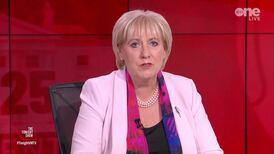Edward Corringham Mannock, better known as Mick, was an Irish nationalist, a Home-Ruler, a trade unionist and socialist who believed that the end of World War One would finally give the “downtrodden their chance.”
It was a war that he would not see end. Instead, Major Mannock, holder of the Victoria Cross, the Distinguished Service Order and Two Bars, the Military Cross and One Bar, was to die in July 1918.
On Friday, members of the Irish Air Corps marched solemnly past a line of plaques in Glasnevin Cemetery commemorating Mannock, as a new stone plaque was unveiled to mark another of Ireland's Victoria Cross holders.
As they did, a small ray of sunshine emerged from a largely overcast sky. Later, the boom of a drumbeat echoed through the Dublin cemetery, followed by a piper’s lament, as a small crowd stood to remember the Irish airman.
Two wreathes were placed at the foot of the Cross of Sacrifice to remember Mannock, who was born in 1887 to his mother, Julia, born in Ballincollig, Co. Cork, and his English father.
Atypical
“It wasn’t just the severe astigmatism in his left eye which made him atypical of his flying officers,” John Green, chairman of the Glasnevin Trust told the gathered audience.
Mannock, who served with the Royal Flying Corps and then the Royal Air Force, was killed on July 26th in Northern France after his aircraft was hit by ground-fire. By then, he had shot down 73 enemy aircraft.
“He was a natural born leader. He was a pioneer in fighter pilot tactics. But he was also modest and humble, acknowledging that he had to overcome his own fears and his own nerves,” Green continued.
Minister of State for Defence Paul Kehoe, who unveiled the plaque, said it was a chance to “reflect on the shared history of our peoples and the responsibility that we share to maintain peace and stability”.
Respectful
Commemorations must remember “the full context of our history” and be “inclusive and respectful of all traditions”, said the Minister of State, adding that “all narratives” should be heard in the years to come.
Speaking of the Irish who fought with British forces during the First World War, Corporal Michael Whelan from the Irish Air Corps said: “It does not matter where these men and women served, where they fell or where they rest.
“The only recourse that falls to us after this passing of time is to try to understand.
“We cannot judge,” said Corporal Whelan. “These men and women are part of the Irish story.”
Also in attendance were British Ambassador Robin Barnett, RAF Air Chief Marshal Sir Stephen Hiller, Brigadier General Sean Clancy, and senior officers from the RAF and Aer Corps, and the Organisation of National Ex-Servicemen and Women.







